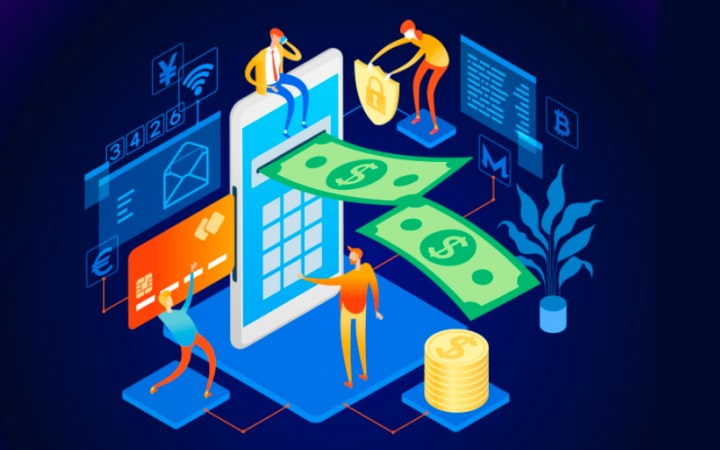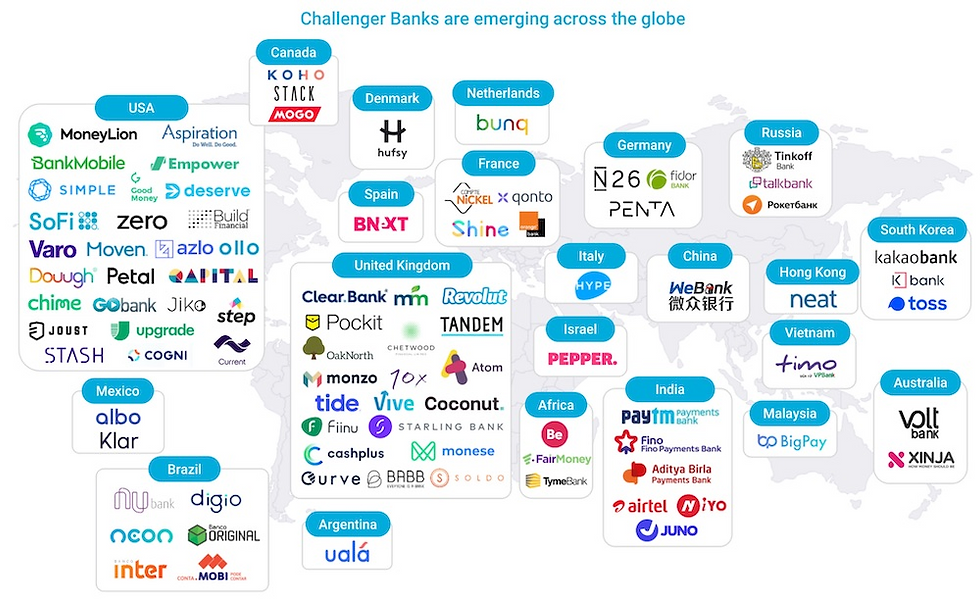What Are Neobanks?
- Rohan Nidmarti
- Jun 1, 2021
- 3 min read
The banking sector has historically been a monopoly, with the world's biggest institutions (Citigroup, Barclays, JPMorgan) maintaining a relatively unchallenged supremacy. The 2008 Financial Crisis resulted in the loss of trillions of dollars worth of financial capital. The rich got richer and the poor got poorer. The wave of anger that the crisis unleashed is still felt today, and in countries such as Japan, France, & Italy just 35% of individuals trust their bank. With confidence at all-time low levels, a group of entrepreneurs have glimpsed a remarkable opportunity, a new kind of digital bank called neobank.

A neobank is a digital-only financial institution that operates exclusively online without traditional physical branches. Neobanks provide a smooth customer experience.
Services Offered by Neobanks:
Intuitive budgeting, investing tools, money transfers, payments, savings accounts, prepaid cards, accounting (with the help of AI/machine learning), taxation services etc.
Neobanks Around the World:
South America- Klar, Uala, Nubank (2nd largest neobank valued at $25 billion)
Europe- Qonto, N26, Klarna (Largest neobank valued at $31 billion)
UK- OakNorth, Revolut, Monzo
India- Zeta
USA- SoFi, Chime

Low Cost Structure:
Neobanks have very little overheads (no physical networks), no monthly fees or withdrawal costs, & provide higher rates on savings/fixed deposits. They also provide free debit cards with large ATM networks of partner & associate banks with no fees. Most neobanks offer limited or no credit to mitigate their risk, and this also helps them keep costs down.
Demographic Changes:
Certain demographic trends are in favour of neobanks. Millennials/Gen-Z form a large part of today's population, and carry out most of their work through the phone. Millennials, who are now entering their years of financial independency, are major customers of neobanks. 42% of Revolut's users are between age 25 and 35.
As internet penetration is increasing, neobanks are targeting the underbanked population. Gig workers have generally stayed away from banking facilities due to their complexity and high-fees, however digital banks have simplified the process. In America, low-income families are now using neobanks to receive their government stimulus check, & transfer money to family members in need. Through these banks, the underbanked have gained a sense of financial security.
Customer Service:
Neobanks are well-known for their superior customer experience & reactive support. They were also early adopters of AI in the banking industry, and provide 24/7 customer care through chatbots. Card replacements are much quicker through these apps, and companies such as N26 provide cards within 2 days compared to the 5 days which traditional banks take. Neobanks are also transparent and provide explanations of any charges or penalties incurred by the customer.

Technology:
Legacy banking institutions have been complacent when it comes to technology. Apps offered by these banks have been hampered by poor functionality and they've found it tough to develop innovate user experiences.
Neobanks allow customers to quickly set up accounts and process requests. Neobanks that offer loans skip the rigid loan-application process in favour of innovate strategies for evaluating credit. SoFi lets you pre-qualify for a loan and see your interest rates within minutes.
Drawbacks:
Neobanks aren't regulated by governments. Neobanks should adhere to the same set of supervisory requirements applicable to traditional banks, however due to their novelty regulation isn't yet in place.
When it comes to digital payments, security will always be a major concern. Neobanks only-digital approach can also be disadvantageous because people prefer going to physical branches when dealing with large loans such as mortgage. Many neobanks also have a narrow range of offerings, and services such as car loans, home mortgages may not be provided.
The Road Ahead:
The global neobank market is going to be worth $400 billion by 2025. Although neobanks are the hottest startups, most of them haven't yet shown sustained profitability. Traditional banks have a warchest bigger than the market cap of many neobanks, and are waiting to see if the concept is successful. Many are now launching apps of their own.
Neobanking can work as an extension of measures undertaken to solve financial inclusion and bundling banking with other financial services. With narrow targets initially, neobanks could expand by adding more services over time. How neobanks manage vital impediments in terms of regulation/compliance, cybersecurity, expansion of offerings will be fundamental determinants of their success.

Thankyou so much for reading, and please do subscribe!



Nice article